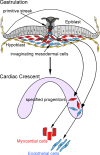Development of the endocardium
- PMID: 20135106
- PMCID: PMC2836465
- DOI: 10.1007/s00246-010-9642-8
Development of the endocardium
Abstract
The endocardium, the endothelial lining of the heart, plays complex and critical roles in heart development, particularly in the formation of the cardiac valves and septa, the division of the truncus arteriosus into the aortic and pulmonary trunks, the development of Purkinje fibers that form the cardiac conduction system, and the formation of trabecular myocardium. Current data suggest that the endocardium is a regionally specialized endothelium that arises through a process of de novo vasculogenesis from a distinct population of mesodermal cardiogenic precursors in the cardiac crescent. In this article, we review recent developments in the understanding of the embryonic origins of the endocardium. Specifically, we summarize vasculogenesis and specification of endothelial cells from mesodermal precursors, and we review the transcriptional pathways involved in these processes. We discuss the lineage relationships between the endocardium and other endothelial populations and between the endocardium and the myocardium. Finally, we explore unresolved questions about the lineage relationships between the endocardium and the myocardium. One of the central questions involves the timing with which mesodermal cells, which arise in the primitive streak and migrate to the cardiac crescent, become committed to an endocardial fate. Two competing conceptual models of endocardial specification have been proposed. In the first, mesodermal precursor cells in the cardiac crescent are prespecified to become either endocardial or myocardial cells, while in the second, fate plasticity is retained by bipotential cardiogenic cells in the cardiac crescent. We propose a third model that reconciles these two views and suggest future experiments that might resolve this question.
Figures


Similar articles
-
The heart endocardium is derived from vascular endothelial progenitors.Development. 2011 Nov;138(21):4777-87. doi: 10.1242/dev.061192. Development. 2011. PMID: 21989917 Free PMC article.
-
Endocardial cells are a distinct endothelial lineage derived from Flk1+ multipotent cardiovascular progenitors.Dev Biol. 2009 Sep 1;333(1):78-89. doi: 10.1016/j.ydbio.2009.06.033. Epub 2009 Jul 1. Dev Biol. 2009. PMID: 19576203
-
Fate diversity of primitive streak cells during heart field formation in ovo.Dev Dyn. 2000 Dec;219(4):505-13. doi: 10.1002/1097-0177(2000)9999:9999<::AID-DVDY1076>3.0.CO;2-6. Dev Dyn. 2000. PMID: 11084650
-
Cardiogenesis with a focus on vasculogenesis and angiogenesis.Anat Histol Embryol. 2020 Sep;49(5):643-655. doi: 10.1111/ahe.12549. Epub 2020 Apr 22. Anat Histol Embryol. 2020. PMID: 32319704 Review.
-
The Endocardium and Heart Valves.Cold Spring Harb Perspect Biol. 2020 Dec 1;12(12):a036723. doi: 10.1101/cshperspect.a036723. Cold Spring Harb Perspect Biol. 2020. PMID: 31988139 Free PMC article. Review.
Cited by
-
An NKX-COUP-TFII morphogenetic code directs mucosal endothelial addressin expression.Nat Commun. 2022 Dec 2;13(1):7448. doi: 10.1038/s41467-022-34991-2. Nat Commun. 2022. PMID: 36460642 Free PMC article.
-
Isolation and Characterization of Porcine Endocardial Endothelial Cells.Tissue Eng Part C Methods. 2023 Aug;29(8):371-380. doi: 10.1089/ten.TEC.2023.0009. Epub 2023 Jul 7. Tissue Eng Part C Methods. 2023. PMID: 37310900 Free PMC article.
-
Differentiation and Application of Human Pluripotent Stem Cells Derived Cardiovascular Cells for Treatment of Heart Diseases: Promises and Challenges.Front Cell Dev Biol. 2021 May 12;9:658088. doi: 10.3389/fcell.2021.658088. eCollection 2021. Front Cell Dev Biol. 2021. PMID: 34055788 Free PMC article. Review.
-
Cardiac Organoids: A 3D Technology for Disease Modeling and Drug Screening.Curr Med Chem. 2024;31(31):4987-5003. doi: 10.2174/0929867331666230727104911. Curr Med Chem. 2024. PMID: 37497713 Review.
-
Cardiac cell lineages that form the heart.Cold Spring Harb Perspect Med. 2014 Sep 2;4(9):a013888. doi: 10.1101/cshperspect.a013888. Cold Spring Harb Perspect Med. 2014. PMID: 25183852 Free PMC article. Review.
References
-
- al Moustafa AE, Chalifour LE. Immortal cell lines isolated from heart differentiate to an endothelial cell lineage in the presence of retinoic acid. Cell Growth Differ. 1993;4:841–847. - PubMed
Publication types
MeSH terms
Grants and funding
LinkOut - more resources
Full Text Sources

